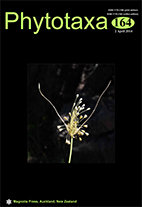Abstract
Feldmann (1970: 249), quoting the results of Hustede (1960), who had shown that Bryopsis halymeniae Berthold (1882: 497) was the gametophyte of a Derbesia sp.[1], pointed out that this species could not belong to the genus Bryopsis differing from it in chloroplasts with no pyrenoids and gametes without a stigma. On that basis, as well as because of its peculiar life cycle, he stated that Bryopsis halymeniae should be considered the type of a new genus: Bryopsidella. Even though Feldmann (1970) did not explicitely propose the new combination Bryopsidella halymeniae, such a binomial was reported by Gallardo et al. (1993: 412, note 60) and by Boudouresque & Per-ret-Boudoure-sque (1987: 83).
[1]A more complete paper showing that Derbesia neglecta and Bryopsis halymeniae are phases of one species, was later published by Hustede (1964).

